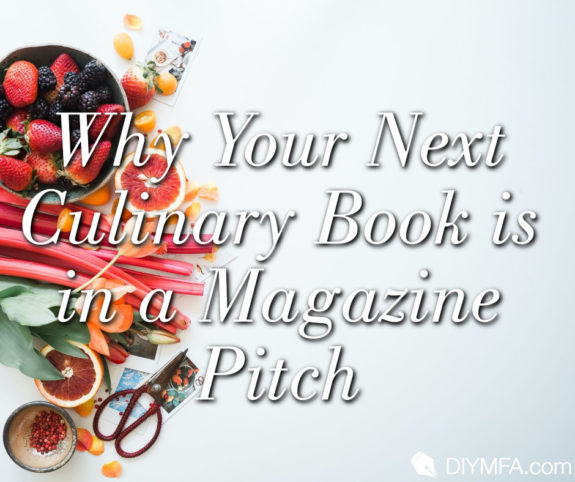Choosing your next food book idea can be scary. It takes bravery to commit to an idea and follow through with its development. So, how do you go about deciding on one? Well, it just might be in your next culinary magazine pitch.
Writing for a magazine might not be the first thing on your mind when you think of your next food book. However, Nigella Lawson, Anthony Bourdain, and Toni Tipton-Martin were journalists or magazine writers before they released celebrated and award-winning culinary books. Then there’s Food 52’s Amanda Hesser and the iconic Ruth Reichl who both snagged jobs at publications after their debut books came out.
Pitching to a culinary magazine requires an intense knowledge of a subject, a reason you’re the one who is meant to write that piece and a seed of a larger story aka your book. Here’s how to get to your book idea with your next magazine pitch.
Explain Your Idea in A Sentence or Two
Be it screenplays or full-length novels, the elevator pitch stumps writers more than the work itself, and the food world is no different. Culinary pitching may be more difficult because everyone is an expert in the kitchen now. Also, when you pitch to agents and publishers, you’ll need a quick sell in your back pocket as you talk up your book.
In the beginning, there may be this inkling of what the story is and how you’ll write it. People probably ask how the book is going, and you give a lengthy response that’s met with enthusiasm. You may have journals and notebooks with ideas and have even spent some time in the kitchen developing some recipes. The idea isn’t quite there, but you feel like you’ll be able to describe your book when it’s complete. So, you’re on a good path, right?
Not quite. If you can’t sum up your idea into a sentence or two, you don’t have a book — yet.
Pitching to a magazine though forces you to think about the essentials needed to describe your story. It eliminates the fluff and vagueness, so people know what your story is and why they should care immediately.
Have a Bold or Unique Culinary Angle
With the rise of the celebrity chefs and influencer home cooks, you don’t have to go far to see how saturated the culinary market is. Not that you shouldn’t pursue your book idea, but you need to be intentional about why it should exist.
In improv, a performer shouldn’t enter a scene unless they have something to add to it. It’s the same with writers. There should be a reason you’re writing the book you are. Food writing is tricky because the majority of readers have access to full kitchens where they can experiment with millions of recipes on the internet.
So, ask yourself: What’s my solution or point of view for a common problem or topic?
It was Bourdain’s article “Don’t Eat Before Reading This” in The New Yorker that shot him to notoriety and contained much of what you’ll find in Kitchen Confidential, which was published a year later. He was spilling secrets most restaurants or kitchen staff didn’t want you to know. This was probably a conversation he had hundreds of times with colleagues and decided one day to bite the bullet and put the not so tasty truth out there.
Know Where the Story Will End
There are two kinds of writers: Those who write by the seat of their pants and those who plot their work before they begin.
In journalism, you have an idea of a story, and it may turn into something unexpected, but for the most part, you know what the conclusion will be. With book writing, it’s easy to brush off the need to know where the story will end. Most writers believe they’ll figure it out along the way. More often than not, the pages are more freewriting than structured, with many scenes happening for no reason.
Food writing trips people up because they believe universal experiences, like eating and cooking together, don’t require a full narrative. Readers will just “get it”. However, Amanda Hesser’s Cooking for Mr. Latte chronicles her year long courtship with her now husband. There’s an expiration date on the story starting in the introduction. It’s also not just a book about food, but about how her relationship transformed her time in the kitchen.
Giving yourself a light structure for a pitch allows you to keep some guardrails on. Your book can’t contain every story you’ve ever imagined. There has to be some discernment.
Focus On the Benefit It’ll Bring Readers (and Publication)
You can’t have a successful pitch without thinking of the person on the other side. Writers make the mistake of focusing on how writing for a publication will help them, but fail to address how it will add value for the editors and readers.
How will someone’s life be easier or better by reading your work? Is there a common myth you want to dispel? What will a reader lose by not taking your advice? Is this the right story for this publication?
Even if you’re a well-known food writer, editors want there to be a meaningful takeaway for their readers. People share impactful ideas. So if your story creates a clear benefit, chances are readers will want to share your work, which will increase the publication’s website traffic.
Working through each of these elements will not only help you figure out the story you want to write, but it will give you an edge for every story moving forward. Knowing how to pitch your work is essential for every writer, and if you can nail a solid pitch for your next food piece with a magazine, you’re well on your way to the next mountain — your book.

Amanda Polick is a book coach for food and entertainment professionals based in Nashville, Tennessee. When she’s not eating her way through her newest stack of cookbooks, this former actor and improviser can be found looking for her next favorite performer. Her work has been featured in Cooking Light, Food & Wine, and Time and is now a regular columnist for DIYMFA. To reach out or learn more, visit her website for free inspiration and book writing guides.







